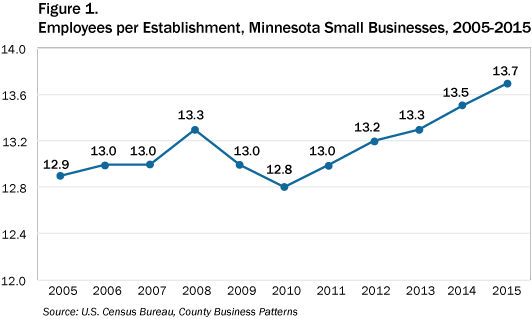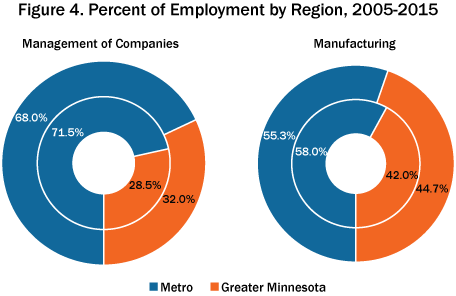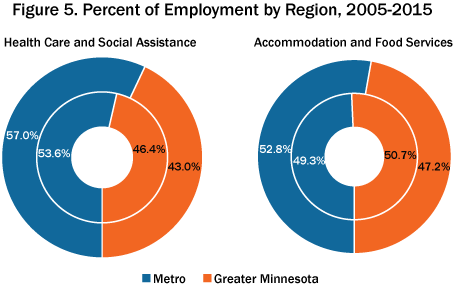by Chet Bodin
December 2017
According to the Small Business Administration, a small business employs fewer than 500 employees. However, over 94 percent of businesses in Minnesota are much smaller, employing less than 50 employees. But these were just the businesses with employees. In addition, the U.S. Census Bureau reports that Minnesota is also home to over 397,000 non-employer businesses or those residents who are self-employed. Together, there are over 500,000 businesses in Minnesota with 0-499 employees, the vast majority. To say they are vital to Minnesota's economy is a major understatement. In 2016 small businesses were responsible for 52 percent of private jobs overall and nearly 60 percent of those in Greater Minnesota. It's important to understand how small businesses, the bread and butter of the state's economy, were affected by the Great Recession and their subsequent makeup today.
| Table 1. Employers by Size Class, 2015 | ||||
|---|---|---|---|---|
| Number of Employees | Minnesota | Greater Minnesota | ||
| Number of Firms | Percent of Firms | Number of Firms | Percent of Firms | |
| 1-4 | 79,797 | 53.7% | 35,526 | 53.9% |
| 5-9 | 26,348 | 17.7% | 12,952 | 19.7% |
| 10-19 | 19,740 | 13.3% | 8,854 | 13.4% |
| 20-49 | 13,847 | 9.3% | 5,470 | 8.3% |
| 50-99 | 4,828 | 3.2% | 1,705 | 2.6% |
| 100-249 | 2,870 | 1.9% | 973 | 1.5% |
| 250-499 | 789 | 0.5% | 282 | 0.4% |
| 500 or more | 447 | 0.3% | 139 | 0.2% |
| Total Firms | 148,666 | 100.0% | 65,901 | 100.0% |
| Source: U.S. Census, County Business Patterns | ||||
In Minnesota small businesses drive the economy. While large employers also play a pivotal role, they often started out as small businesses themselves. But in Greater Minnesota small businesses are even more crucial to the economy, where 99.7 percent of all businesses fit the definition in 2015 that is based on number of employees. But the number of small businesses changed dramatically during the Great Recession. This change is evident in regional trends from 2005, four years before the recession, to 2015, four years after the recession.
From 2005-2015 the number of small businesses decreased in every part of the state, including the Seven-County Metro Area. Central Minnesota was the only region in Greater Minnesota with a slower loss in small businesses than the Metro Area during that stretch. But while the Metro Area added non-employers at a 13.1 percent rate, Central Minnesota lost non-employers. Outside the Metro Area Southeast Minnesota was the only region to add non-employers from 2005-2015. At the same time Southeast Minnesota was shedding other small businesses, those with employees, at 4.2%, the second fastest rate of loss in the state. Northeast Minnesota suffered the fastest loss of small businesses from 2005-2015, both in terms of those with employees and without.
While the loss of small businesses is detrimental to any region, not all small business loss is caused by closings. In some cases businesses move out of the state or grow out of the small businesses categorization. In fact, Minnesota businesses with more than 500 employees increased by 17 percent from 2005-2015 (see Table 2), as the state added a total of 64 'large businesses'.
| Table 2. Percent Change in Small Business Establishments, 2005-2015 | |||||||
|---|---|---|---|---|---|---|---|
| Business Size | Minnesota | Northwest Minnesota | Northeast Minnesota | Central Minnesota | Southwest Minnesota | Southeast Minnesota | Twin Cities Metro |
| Small Businesses | -1.1% | -2.5% | -5.0% | -0.1% | -3.3% | -4.2% | -0.4% |
| Large Businesses | 16.7% | -13.0% | 0.0% | 32.1% | -5.3% | 6.9% | 15.8% |
| Non-Employers | 6.4% | -0.8% | -7.3% | -1.2% | -0.2% | 0.4% | 13.1% |
| Source: U.S. Census Bureau: 2005-2015 County Business Patterns; 2005-2015 Non-Employer Statistics | |||||||
The loss of small businesses in Minnesota has not translated to less employment at such establishments. Not including non-employers, employment at businesses with less than 500 employees actually increased by 5.0 percent from 2005-2015. In effect, the number of employees per small businesses increased in Minnesota from 12.9 in 2005 to 13.7 in 2015 (see Figure 1).

The rate of job growth at small businesses has been similar in all regions of the state, ranging from a 3.5 percent increase in Northeast Minnesota to a 5.9 percent increase in Southeast Minnesota. Small businesses throughout the state added nearly 60,000 jobs from 2005-2015, and almost two-thirds of those were added in the Twin Cities Metro Area. However, businesses in Greater Minnesota increased employee wages faster than their Metro Area counterparts (see Table 3). From 2005-2015 average monthly wages per employee rose in three of the five regions of Greater Minnesota at a higher rate than in the Metro Area. In both Northwest and Southwest Minnesota average monthly wages increased by one-third over the 10-year period.
| Table 3. Percent Change in Employment and Wages, Small Businesses (under 500 employees) 2005-2015 | |||||||
|---|---|---|---|---|---|---|---|
| Subject | Minnesota | Northwest Minnesota | Northeast Minnesota | Central Minnesota | Southwest Minnesota | Southeast Minnesota | Twin Cities Metro |
| Employment | 5.0% | 4.0% | 3.5% | 4.2% | 3.0% | 5.9% | 5.6% |
| Average Monthly Wages | 21.8% | 33.7% | 27.5% | 11.4% | 34.2% | 18.4% | 20.3% |
| Source: U.S. Census Bureau, Quarterly Workforce Indicator (QWI) Explorer | |||||||
Generally speaking an increase in wages is often meant to draw more workers to a region. Although small businesses in the metro added more employment than Greater Minnesota from 2005-2015, they also suffered greater losses during the recessionary period. For example, from 2007-2009 small business employment decreased 6.2 percent in the metro compared to only 3.7 percent in Greater Minnesota (see Figure 2). It appears small employers in Greater Minnesota succeeded in building their workforce at least temporarily. Despite the employment losses both in and out of the metro during the recession, the percent of statewide jobs in Greater Minnesota increased by 1.1 percent during this time.

Small businesses weathered significant economic fluctuation from 2005 to 2015, but distinct trends emerged before and after the recession. In both the Metro Area and Greater Minnesota small business employment decreased from 2005-2010, but rebounded dramatically from 2010-2015. Again, the economic fluctuation was more pronounced in the Metro Area (see Table 4).
| Table 4. Minnesota Small Business Employment 2010-2015 | ||||||
|---|---|---|---|---|---|---|
| 2005 | 2010 | Percent Change 2005-2010 | 2015 | Percent Change 2010-2015 | Percent Change 2005-2015 | |
| Twin Cities Metro | 684,385 | 637,779 | -6.8% | 722,911 | 13.3% | 5.6% |
| Greater MN | 500,066 | 486,737 | -2.7% | 520,940 | 7.0% | 4.2% |
| State of Minnesota | 1,184,451 | 1,124,516 | -5.1% | 1,243,851 | 10.6% | 5.0% |
| Source: U.S. Census Bureau, Quarterly Workforce Indicators | ||||||
With some exceptions the back and forth trends were evident in most major industries as well. Small businesses shed employment in 11 of the 19 private industry sectors from 2005-2010. But from 2010-2015, each of these industries had positive employment gains (see Figure 3). Small businesses in Construction and Manufacturing dealt with the largest employment swings over this time. Small businesses statewide lost over 36,500 Construction jobs from 2005-2010 but added almost 24,500 back from 2010-2015. Similarly, small Manufacturers shed over 17,600 workers from 2005-2010 then added almost 14,000 the next five years.

In other industries small businesses managed to add employment during the recession and recovery periods. Agriculture and Forestry, Transportation and Warehousing, Management of Companies and Enterprises, Health Care and Social Assistance, Arts, Entertainment and Recreation, and Accommodation and Food Services each added employment from 2005-2010 and 2010-2015. Small businesses in Health Care and Social Assistance led the way by adding 41,200 jobs over the 10-year period, a 26.5 percent increase.
Four of these industries demonstrate how employment in small businesses shifted geographically in Minnesota from 2005-2015: Management of Companies, Manufacturing, Healthcare and Social Assistance, and Accommodation and Food Services. In the case of both Management of Companies and Manufacturing the percentage of jobs in Greater Minnesota provided by small businesses was higher in 2015 (see Figure 4). This amounted to an additional 717 Management jobs and 1,268 Manufacturing jobs in Greater Minnesota compared to before the recession.

However, the regional shift in Manufacturing resulted more from large employment losses in the Metro Area, whereas small businesses in Greater Minnesota added jobs at a higher rate than the Metro, but both regions saw growth.
By 2015 the Metro Area captured a higher percentage of small business employment in Health Care and Social Assistance and Accommodation and Food Services. In 2015 these were two of the top three industries in terms of small business employment statewide, but growth during and after the recession was concentrated in the Twin Cities.
Small Businesses in Health Care and Social Assistance added over 28,800 jobs in the Twin Cities Metro Area from 2005-2015, compared to an addition of nearly 12,400 in Greater Minnesota. Interestingly, small businesses in Health Care grew faster in Greater Minnesota from 2005-2010, but stalled from 2010-2015 while employment in the Metro Area continued to grow. Because of this, 57 percent of industry jobs provided by small businesses were in the Metro by 2015.
Accommodation and Food Services, which was the third largest industry in Greater Minnesota for small business employment in 2015, exploded in the metro area from 2005-2015. Over that stretch, small business employers added almost 16,000 jobs in the metro area compared to approximately 5,300 in Greater Minnesota. Small businesses in both areas added more jobs in 2010-2015, but the metro area boom resulted in its containing more than half the state's small business jobs in Accommodation and Food by 2015 (see Figure 5).

The economic fluctuation from 2005-2015 had significant effects on small businesses statewide. Notably, the number of small businesses in the state has decreased, but on average those which exist today have more employees. The recession hit some industries more than others, but small businesses added employment in nearly every industry during the recovery. However, the losses and subsequent gains were not geographically synchronized in Minnesota, and have led to a change in the regional distribution of small business employment in the state.
Small businesses have, however, continued to grow in Minnesota. Statewide, small business added another 14,361 jobs in 2016, although the vast majority were in the Twin Cities Metro Area. While Greater Minnesota was not affected by the recession as much, small businesses will need to continue to find ways to attract workers. In 2016 average monthly wages again increased in Greater Minnesota by $48 to $2,967, but unlike past years, wage growth in the metro outpaced them, growing by $87 to $4,401. Given that wages in the metro exceed those in Greater Minnesota by so much to begin with, small businesses outside the metro will have to keep pace to keep up.